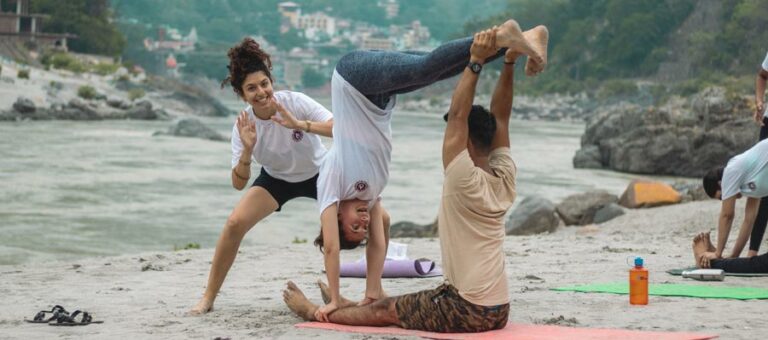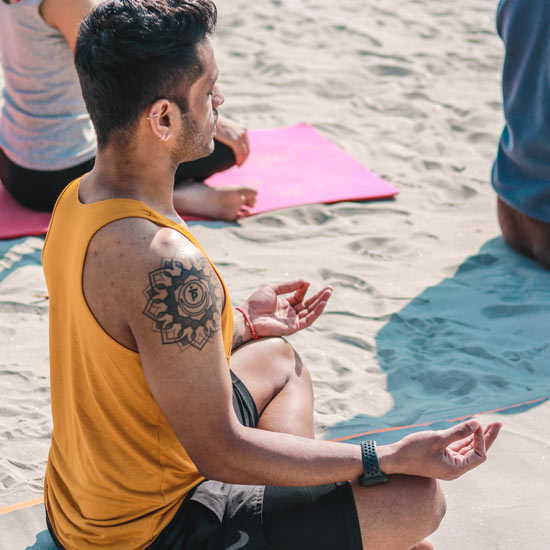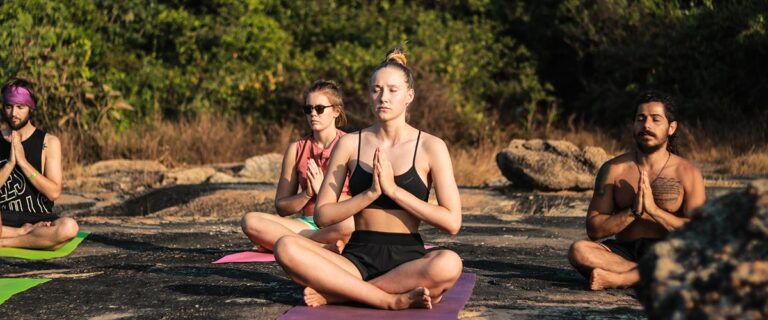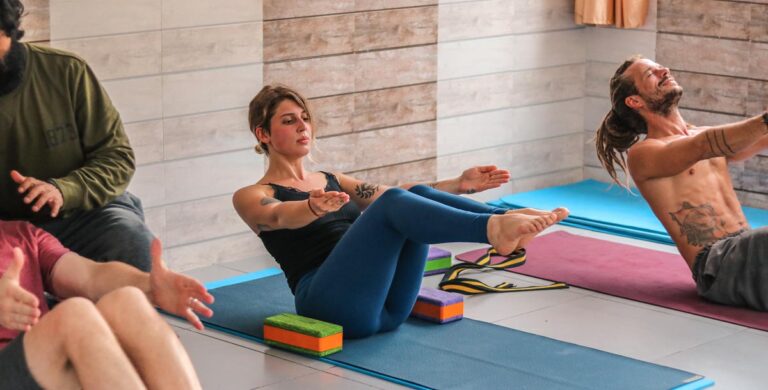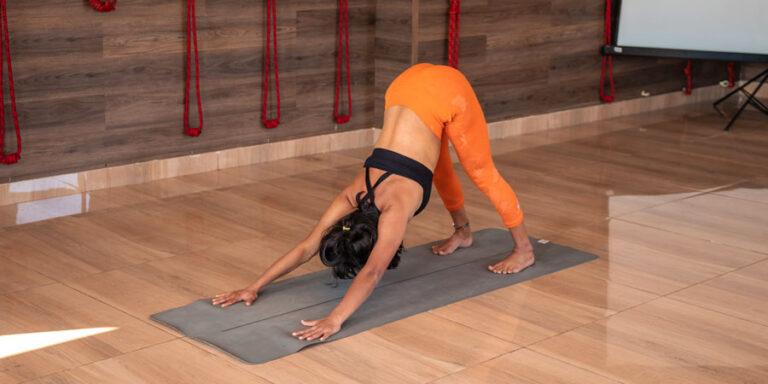Vrikshasana or Tree Pose: How to Do It, Benefits, Step-by-Step Instructions & Precautions
Introduction to Vrikshasana
Vrikshasana, or Tree Pose, is a fundamental yoga posture that promotes physical and mental balance. In this pose, the practitioner stands on one leg while bringing the other foot to rest on the inner thigh or calf of the standing leg, extending their arms upward or keeping them in a prayer position. Tree Pose is celebrated for improving stability and mental focus, making it an essential posture for practitioners of all levels. It is particularly effective for cultivating concentration, mindfulness, and a strong mind-body connection.
What is Vrikshasana?
Vrikshasana, from the Sanskrit words Vriksha (meaning tree) and Asana (meaning posture), is often referred to as Tree Pose because it mimics the steady and rooted stance of a tree. The pose invites the practitioner to “root” into the Earth with one leg while reaching for the sky with the other, symbolizing harmony between strength and flexibility. The pose is believed to be inspired by the ancient yogic connection to nature, emphasizing the grounding aspect of yoga practice.
Tree Pose embodies the yoga philosophy of Sthira Sukham Asanam (Patanjali’s Yoga Sutra 2.46), which refers to the idea of practising with both steadiness and ease. The pose is deeply connected to the notion of rootedness and stability, symbolic of how one should remain steady and grounded in life while remaining flexible and adaptable. By practising Vrikshasana, one cultivates the balance of strength and serenity—both physically and mentally—reflecting the deeper mindfulness principles found in yoga.
Health Benefits of Vrikshasana
Tree Pose significantly improves your sense of balance and stability. By standing on one leg, you activate the small stabilizing muscles in the foot and ankle, which promotes joint mobility and alignment. Over time, this helps improve coordination or the awareness of your body in space.
The pose engages the muscles of the standing leg, especially the quadriceps, calves, and hamstrings. Holding Tree Pose also strengthens the core as it helps stabilize the spine and pelvis, fostering better posture and overall body strength.
Vrikshasana demands concentration on a fixed point to maintain balance, which naturally calms the mind and promotes mental clarity. This mindfulness aspect reduces anxiety, enhances focus, and improves the ability to concentrate, benefiting both the body and the mind. It also encourages a deeper connection with the breath, helping to relieve stress and promote emotional calmness.
Poses to Enhance Balance and Flexibility:
- Tadasana (Mountain Pose): This foundational pose strengthens the legs, improves posture, and enhances body awareness.
- Uttanasana (Forward Fold): Helps stretch the hamstrings and release tension in the legs, which can aid in balancing.
- Vrksasana with Wall Support: Practicing Tree Pose with the support of a wall or prop can help develop the balance needed to hold the pose independently.
Warm-Up Stretches to Prevent Injuries:
- Hip Openers (like Baddha Konasana and Lizard Pose) can help increase hip flexibility for the lifted leg.
- Calf and Hamstring Stretch to prepare the legs for standing and maintaining balance.
- Gentle Forward Bends to stretch the back and release tension.
Step-by-Step Guide to Performing Vrikshasana
- Start in Tadasana (Mountain Pose): Stand tall, with your feet hip-width apart, arms by your sides, and weight evenly distributed.
- Shift Weight onto One Leg: Gently bend one knee and place the sole of the opposite foot against the inner thigh or calf of the standing leg (avoid the knee).
- Find Your Balance: Press your foot into the thigh and your thigh into the foot for stability. Engage your core muscles and lengthen your spine.
- Bring Hands to Prayer Position: Place your palms together in front of your chest or, if balanced, extend your arms overhead, palms facing each other.
- Focus Your Gaze: Choose a fixed point in front of you to focus on, which will help you maintain balance.
- Hold the Pose: Stay in the pose for 20–30 seconds or longer, depending on your balance.
- Release and Switch Sides: Gently lower your leg, returning to Tadasana, and repeat on the opposite side.
Visual Cues:
- Keep your lifted leg active and avoid collapsing your foot inward.
- Align your hips and shoulders, ensuring that your body stays upright.
- Maintain a soft gaze (drishti) to help with balance.
Common Mistakes and How to Avoid Them
- Foot Positioning: Avoid placing the foot directly on the knee as it can strain the joint. Place the foot on the inner thigh or calf.
- Lack of Core Engagement: Without engaging your core, it’s easy to lose balance. Draw your navel toward your spine to maintain stability.
- Wobbly Hips: Ensure your hips are level, and avoid letting your lifted knee collapse inward.
- Excessive Leaning: Keep your body aligned and avoid leaning forward. Your torso should remain upright and tall.
Tips for Correcting Form:
- Place your foot higher on your leg to find balance.
- Use props (e.g., a block under the foot) to enhance stability.
- Practice near a wall or use it for support while building strength.
Precautions and Contraindications
- Avoid this pose if you have knee or ankle injuries, as it places weight on the standing leg.
- If you have hip or groin issues, avoid placing your foot too high on your leg. Keep it below the knee on the calf or ankle.
- If you experience vertigo or dizziness, practice Tree Pose near a wall or with support.
- Pregnant individuals should avoid placing pressure on the abdominal area and may want to practice modified versions with wall support.
- Those with a history of balance problems should start with gentle variations or practice with a chair for added support.
Conclusion
Vrikshasana, or Tree Pose, is a powerful tool for improving physical balance, mental focus, and overall stability. By incorporating this pose into your yoga practice, you enhance both your strength and flexibility while promoting mindfulness. Remember to practice with awareness, paying attention to alignment and posture. Over time, Tree Pose will not only improve your yoga practice but will also help you develop a stronger mind-body connection.
FAQs
Q: How long should I hold Tree Pose?
Start with 20-30 seconds and gradually increase as your balance improves. Aim for at least one minute on each side for deeper benefits.
Q: Is Tree Pose good for beginners?
Yes, Tree Pose can be modified to suit beginners. It’s a great starting point to build balance and concentration.
Q: Can I do Tree Pose if I have knee problems?
If you have knee issues, avoid placing the foot on the knee. Instead, position the foot lower on the calf or ankle to protect the joint.
Q: Can Tree Pose help reduce stress?
Yes, by promoting mindfulness and concentration, Tree Pose helps calm the mind and reduce anxiety.
Q: Can Tree Pose be done with eyes closed?
Closing your eyes can deepen the challenge, but it’s not recommended for beginners as it may cause you to lose balance.


